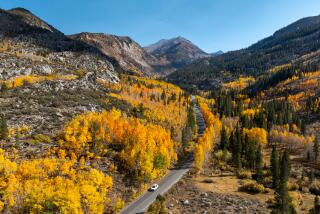A World of Change Comes With...
It’s time to prepare for a climate change. Time to fire up the furnace, check the woodpile, pull the sweaters out of mothballs and air out the down comforter. The daily average temperature in Los Angeles will fall more than 15 degrees Fahrenheit over the next few months. The typical monthly rainfall will increase at least tenfold over the same period. But these impending events are not the fulfillment of an apocalyptic prediction, nor the consequences of human activities on the environment. They are part of one climate change to which we are well accustomed: the beginning of autumn.
Autumn officially began Saturday at 5:13 a.m., Los Angeles time.
From a vantage point in space, satellites have recorded the changing climate in Los Angeles as part of a gradually shifting global pattern, a seasonal wave. Satellites began providing views of Earth’s atmosphere and surface in the early 1960s, with the launch of TIROS 1. As the quality of instruments improved, and as Earth-observing satellites became more numerous, scientists obtained an increasingly clear and more complete picture of conditions on the planet.
Among the satellite observations are global cloudiness, vegetation cover and snow and ice distribution. All three change with the seasons. Their behavior reveals the interconnected nature of climate on Earth. The Earth pulses with a seasonal rhythm.
A late-summer overview of the surface cover of Earth was produced by computer from numerous cloud-free satellite images taken during September, 1992 (see top map). Two belts of green stand out in the Northern Hemisphere, one in the tropics (which includes the tropical rain forests), the other in the so-called mid-latitudes. Between the two belts, the Earth is girdled by arid lands--the Sahara, Arabian, Gobi and Sonoran deserts.
As seen from space, the tropical belt of green creeps northward all summer. It is escorted on this journey by a broken band of clouds that circles the globe, made up largely of giant thunderheads. These clouds bring life-giving summer rain to plants and shrubs in places such as Nigeria, Venezuela and the southeast part of China. (The clouds show up in weather satellite pictures, but do not appear in the cloud-free images from which these illustrations were made.)
The mid-latitude greenbelt expands northward a great deal faster. Summer witnesses the greening of most of Europe, southern Siberia and much of North America. Plants actually use up about 2% of the carbon dioxide in the atmosphere to make building materials for this seasonal growth.
In autumn, the belts of vegetation reverse direction, going south for the winter (lower map). The tropical greenbelt recedes toward the edges of perennial rain forests. Grasses of the Savannah dry up. The southern boundary of the tropical belt will compensate for the loss by advancing farther south.
The mid-latitude belt shrinks and in some places disappears entirely. The continents cool and summer monsoon winds collapse. Leaves fall in New England. From space, Iowa takes on earthy brown tones. Sea ice and snow cover at high northern latitudes begin their annual advance.
This has to do with the way sunlight falls on Earth. The planet’s spin axis is tilted in its orbit around the sun. Over the course of a year, the south and the north poles each take a turn pointing toward the sun. When the north pole points toward the sun, it is northern summer, and the sun never sets in the Arctic region. In winter, the north pole points away from the sun and the Arctic is in total darkness.
According to the calender, we have survived the dry, hot climate of summer. Storm patterns in mid-latitudes will soon intensify and migrate southward; with luck, they will bring along seasonal rains.
Viewed from space, Los Angeles is at a crossroads between advancing and retreating bands of green and red-brown. Autumn is upon us. It is time to prepare for the next phase of the global progression of seasons.
* Ralph Kahn is a research scientist at the Jet Propulsion Laboratory in Pasadena.
More to Read
Sign up for Essential California
The most important California stories and recommendations in your inbox every morning.
You may occasionally receive promotional content from the Los Angeles Times.










